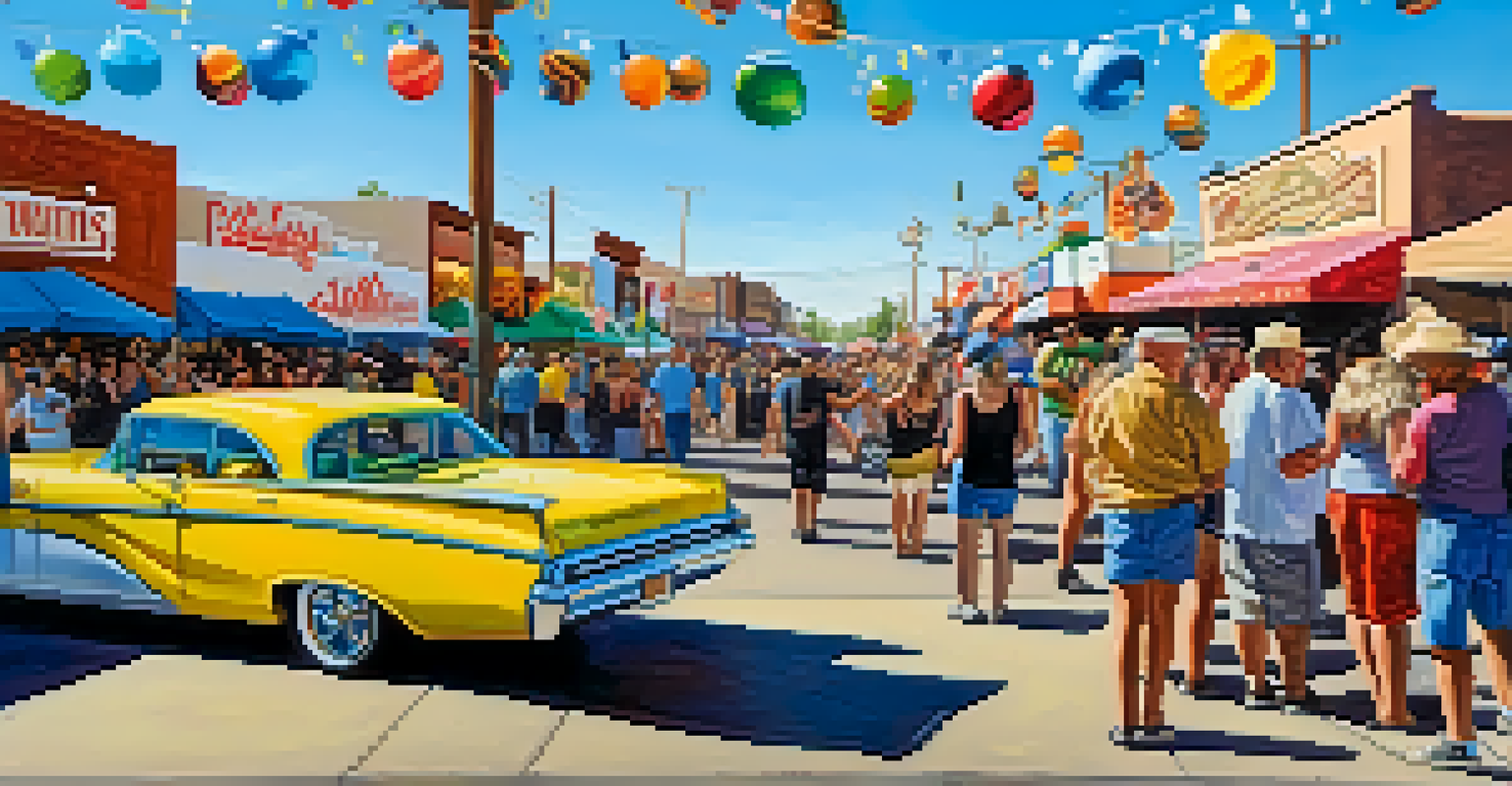The Cultural Impact of Route 66 on Arizona's Communities

The Historical Significance of Route 66 in Arizona
Route 66, often dubbed the 'Main Street of America,' has a rich history that dates back to its establishment in 1926. For Arizona, this highway was more than just a road; it symbolized a connection to the rest of the nation and an opportunity for economic growth. Towns along the route flourished as travelers stopped to refuel and rest, creating a unique blend of cultures and experiences.
The road to success is dotted with many tempting parking spaces.
As the highway developed, it became a lifeline for local businesses, from motels to diners, helping to define the character of small towns like Williams and Kingman. These establishments not only provided services but also fostered a sense of community, offering locals and travelers alike a place to mingle and share stories. This burgeoning social scene helped to shape the identity of these towns beyond their geographical locations.
Today, many of these historical landmarks have been preserved, serving as a reminder of the past while attracting tourists. The cultural significance of Route 66 remains deeply rooted in Arizona's communities, illustrating how a roadway can transform lives and local identities.
Cultural Melting Pot: Diverse Communities Along Route 66
Traveling along Route 66 in Arizona reveals a tapestry of cultures, reflecting the diverse communities that have thrived here. From Native American heritage to Hispanic influences, this highway has been a conduit for cultural exchange. Each town offers its own unique flavor, contributing to a rich narrative that enriches the overall experience of the route.

For example, the town of Flagstaff showcases its Native American roots through art galleries and festivals celebrating indigenous culture. Similarly, the Hispanic heritage in towns like Tucson adds to the vibrant atmosphere, with colorful markets and traditional cuisine that invite exploration. These cultural elements not only attract visitors but also instill pride within the local communities.
Route 66: A Catalyst for Community
Route 66 has played a crucial role in shaping the identity and economy of Arizona's towns, fostering local businesses and community interactions.
As travelers embark on their journey along Route 66, they are often met with friendly faces eager to share their stories and traditions. This sense of community fosters connections among people from different backgrounds, promoting understanding and appreciation of Arizona's cultural diversity.
Route 66 and the Rise of Roadside Attractions
One of the most iconic aspects of Route 66 is its array of quirky roadside attractions, which have become cultural landmarks in their own right. From the giant blue whale in Catoosa to the iconic Wigwam Motel, these attractions draw visitors looking for a slice of Americana. In Arizona, you'll find treasures like the London Bridge in Lake Havasu City and the Route 66 Museum in Victorville, showcasing the whimsical side of travel.
Travel is the only thing you buy that makes you richer.
These attractions not only serve as photo opportunities but also contribute significantly to local economies. They encourage tourists to stop and explore, leading to increased patronage of nearby shops and restaurants. As a result, these unique sites help preserve local culture while providing a nostalgic glimpse into the past.
Moreover, the presence of these attractions fosters a sense of community pride. Residents often take it upon themselves to maintain and promote these landmarks, ensuring they remain vibrant parts of Arizona's cultural landscape for future generations.
Impact on Local Economies and Tourism
Route 66 has had a profound impact on the local economies of Arizona's communities, primarily through tourism. As travelers flock to experience the nostalgia of this historic route, they contribute to a thriving economy that benefits local businesses. Restaurants, gift shops, and lodging establishments often see increased patronage, bolstered by the influx of visitors eager to explore.
Communities along the route have adapted to this tourism boom by hosting events and festivals that celebrate their unique heritage. These gatherings not only attract more visitors but also engage locals, creating a sense of unity and purpose. For instance, the annual Route 66 festival in Kingman has become a beloved tradition, drawing crowds and fostering community spirit.
Cultural Diversity Along Route 66
The highway serves as a melting pot of cultures, showcasing Native American and Hispanic influences that enrich the travel experience.
However, it's important to note that this tourism-driven economy also requires careful management to preserve the authenticity and charm of these towns. Striking a balance between growth and preservation is essential for maintaining the cultural integrity that makes Route 66 a treasured part of Arizona's history.
Art and Music: The Creative Influence of Route 66
The cultural impact of Route 66 extends into the realms of art and music, inspiring countless artists and musicians along the way. The highway has become a muse for many, with its scenic landscapes and vibrant communities serving as backdrops for creative expression. From murals depicting the journey to songs celebrating the freedom of the open road, Route 66 resonates deeply in the artistic psyche.
In Arizona, you can find galleries showcasing works influenced by the highway’s rich history. Local artists often draw inspiration from the iconic scenes and stories that Route 66 embodies, creating pieces that reflect the spirit of adventure and heritage. This artistic output not only enriches the local culture but also attracts art enthusiasts from afar.
Similarly, music inspired by Route 66 celebrates themes of travel and nostalgia, with genres like rock, blues, and country paying homage to the highway. Local venues frequently host live performances that highlight these musical connections, further intertwining the cultural fabric of Arizona with the spirit of Route 66.
Preserving the Legacy of Route 66
As the years go by, the preservation of Route 66's legacy becomes increasingly vital. Many communities in Arizona recognize the importance of maintaining the historical aspects of the highway while embracing modern development. Efforts to restore vintage motels, diners, and roadside attractions help keep the spirit of the route alive for future generations.
Local organizations and government initiatives often collaborate to promote heritage tourism, highlighting the significance of Route 66 in American culture. By engaging residents and educating visitors, these efforts foster a sense of responsibility for preserving the unique charm of the highway. Workshops, festivals, and educational programs play a pivotal role in this mission.
Preserving Route 66's Legacy
Efforts to maintain the historical charm of Route 66 are vital for honoring the stories and experiences that have shaped Arizona's communities.
Ultimately, preserving Route 66 is about more than just maintaining physical structures; it’s about honoring the stories and experiences that have shaped Arizona's communities. By celebrating this legacy, residents ensure that the cultural impact of Route 66 continues to thrive.
The Future of Route 66 in Arizona's Cultural Landscape
Looking ahead, the future of Route 66 in Arizona appears promising as communities continue to embrace its cultural significance. With a growing interest in heritage tourism and a renewed appreciation for vintage Americana, the highway is set to remain a vibrant part of the state’s identity. Local initiatives aimed at revitalizing towns along the route are essential for sustaining this momentum.
Moreover, the digital age offers new opportunities for engagement, with social media platforms and travel blogs showcasing the allure of Route 66. This increased visibility can draw new visitors and inspire younger generations to explore the history of this iconic road. By adapting to modern trends while honoring tradition, communities can ensure the highway remains relevant.

Ultimately, the cultural impact of Route 66 on Arizona's communities is a living narrative, one that evolves with each passing year. As residents and travelers alike continue to celebrate this historic route, they contribute to a rich tapestry of stories that will endure for years to come.